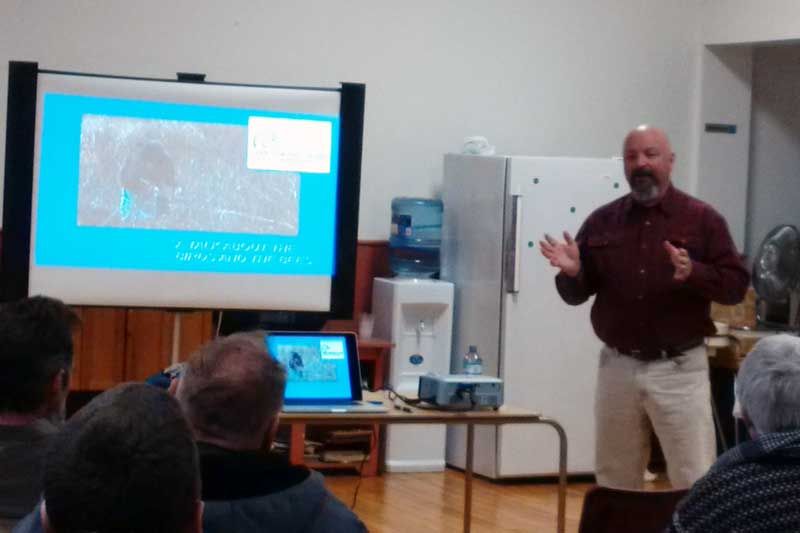Apr 01, 2015
by Jonathan Davies
There has been a lot of focus recently on the crisis faced by honeybees, but for people outside of the conservationist loop, tallgrass is probably not a top-of-mind issue. Where pollinators, as well as birds and a host of other animals are concerned, grasslands are a vital habitat, one whose preservation requires more than passing attention.
Kyle Breault, former coordinator with Tallgrass Ontario, and currently involved in tallgrass planting projects throughout Ontario, was in Marysville on March 26 to talk about the importance of preserving what little native tallgrass habitat is left, while introducing news tracts, including in places where tallgrass may not be native to the landscape. Wolfe Island is one such place, and Breault has being working on projects there for the past three years.
The presentation was the first in the Frontenac Stewardship Foundation's 2015 seminar series. The foundation has been engaged on a number of issues since its founding in 2008, including watershed preservation, invasive species management, and habitat preservation and restoration.
Breault focused on the importance of both birds and bees, and on the misconception that creating habitat for one ignores the other. "Bird habitat and bee habitat are actually the same," he explained to a group of about 30 gathered at Wolfe Island United Church. And while he noted the importance of the Ontario government's plans to curb neonicotinoid use (pesticides in this category have been linked to bee deaths, and where they were previously used as a seed treatment for isolated use by farmers, they have now become a standard coating on the vast majority of corn and soybean seed) he stressed that this was only one part of the solution - the other being that bees simply need more habitat.
In the past two years, working with Ducks Unlimited as the organization's go-to for tallgrass planting, Breault has put about 600 acres back on the ground in the province. While this sounds impressive, he lamented that he is engaged in an uphill battle. "About 100 times as much habitat is ruined in a week as all our efforts combined have put back,” he said.
Breault noted that in Chatham-Kent, where he resides, abundant Carolinian forest is being cut down at such a rate that the forest cover has been reduced to around 2%. To put that in perspective, Environment Canada considers 30% to be the minimum forest cover threshold to ensure marginal species richness and adequate aquatic system health.
As for tallgrass, some of the best in the province would have been found in parts of western Ontario, where one could ride horseback almost unseen because the grasses were so tall. But because these grasses were easier to plow than woodlands, they were the first to go to agriculture, a little under a century ago. Development accelerated as agriculture became industrialized in the 1950s. There was no concerted effort to preserve grassland in Ontario until the 1990s, when Ontario conservationist Allen Woodliffe recognized their importance and began working to keep them alive.
Most of the tallgrass that remains today, according to Breault, are on steep, unworkable land or along railway lines. "We're basically at nothing now." Breault said. There are a few spots, particularly on First Nations, where grassland management - which includes periodic burning - have been a cultural practice. But there are also little fragments that will keep disappearing, regardless of efforts to preserve them, because they have become so brittle.
This is where the next best thing to a natural, native grassland is created. "We mimic. That's all we can do," said Breault. In southern Ontario, most land is privately owned, and when space is made available for a planting, usually by a landowner, Breault is ready to seed it and begin transforming it into habitat.
"You can't turn that down. You either replace it here, or you don't replace it anywhere," he said.
All of the three projects on Wolfe Island that Breault has so far planted were paid for by private companies. The Endangered Species Act in Ontario stipulates that development projects, such as solar or wind farms, have to replace habitat that they have displaced. "The companies that I've dealt with, they're happy to do it, " he said.
Breault's concern is that the Ministry of Natural Resources, which is responsible for enforcing these policies, pushed hard early on to ensure that companies carried through with their responsibilities, but has become slack more recently. This means habitat is being removed but not replaced in a timely manner. Breault noted, "We went from having a dozen projects a year three years ago, to this year where we're still waiting to hear if we're going to have our first one."
More Stories
- Kaladar Station - Sometimes the timing is just right
- 50th Anniversary Party for Rural Frontenac Community Services
- Bioblitz Coming This Week at Piccadilly Property
- Committee recommends looking at an accommodation tax in Frontenac County
- Bobs and Crow Lake Shoreline Restoration
- Ellen Fraser is recognized as the winner of the 2025 MERA Award of Excellence in Fine Art and Fine Craft.
- Addington Highlands Treads Lightly Into F Carney Flag Debate Territory
- Simonett Purchase Raises Questions
- Why This Green Could Not Vote Red
- The Sand Is Still Coloured

